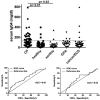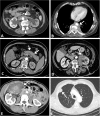Clinical and Prognostic Significance of Serum IgG4 in Chronic Periaortitis. An Analysis of 113 Patients
- PMID: 31019511
- PMCID: PMC6458283
- DOI: 10.3389/fimmu.2019.00693
Clinical and Prognostic Significance of Serum IgG4 in Chronic Periaortitis. An Analysis of 113 Patients
Abstract
Objective: Chronic periaortitis (CP) is a rare fibro-inflammatory disorder that incorporates idiopathic retroperitoneal fibrosis, inflammatory abdominal aortic aneurysms, and perianeurysmal retroperitoneal fibrosis. CP is included in the spectrum of IgG4-related disease. Since CP patients rarely undergo diagnostic biopsies, serum IgG4 levels are often used to classify CP as IgG4-related. However, the clinical and prognostic significance of serum IgG4 in CP is unknown. Methods: We measured serum IgG4 in active CP patients and compared the clinical characteristics, response to therapy and outcome of patients with high and normal levels. We also tested the diagnostic significance of IgG4 by comparing its levels in CP patients, healthy and disease controls (malignancies, Erdheim-Chester disease, large-, and small-vessel vasculitis). Results: We studied 113 consecutive patients with active CP. Twenty-four (21.2%) had high serum IgG4 (>135 mg/dL). The demographic, laboratory, and clinical characteristics of patients with high and normal IgG4 were similar, and so were the rates of ureteral obstruction and the disease characteristics on CT, MRI, and 18F-FDG-PET. Patients with high IgG4 only had a higher frequency of extra-retroperitoneal fibro-inflammatory lesions (p = 0.005). There were no significant differences in response to therapy and relapses between the two groups. Serum IgG4 levels did not discriminate CP from controls. Conclusions: Serum IgG4 levels are high in a minority of CP patients and do not identify specific clinical or prognostic subgroups; only a higher frequency of extra-retroperitoneal lesions is found in high-IgG4 patients. Serum IgG4 levels do not help in the differential diagnosis between CP and its mimics.
Keywords: IgG4; IgG4-related disease; fibro-inflammatory disorder; hydronephrosis; periaortitis; retroperitoneal fibrosis.
Figures




References
-
- Parums DV. The spectrum of chronic periaortitis. Histopathology. (1990) 16:423–31. - PubMed
MeSH terms
Substances
LinkOut - more resources
Full Text Sources
Miscellaneous

